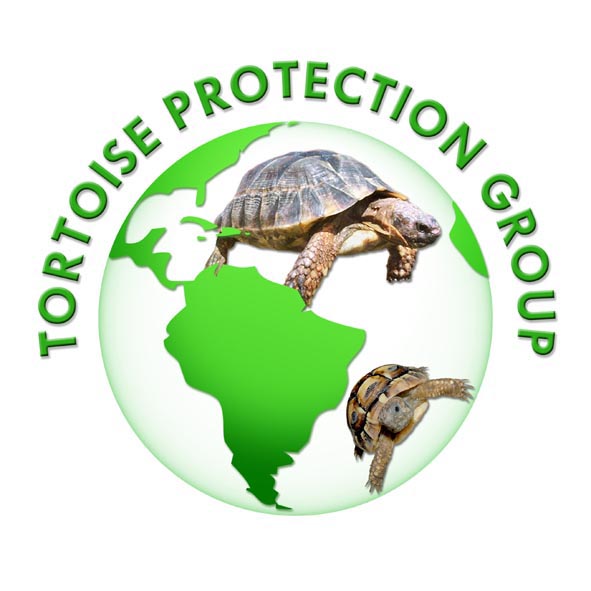Guidance on dealing with egg sacs which are not fully absorbed in a newly hatched tortoise
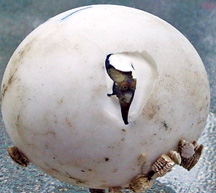
During embryonic development, nutrition is received from the yolk sac and this is usually not visible when the tortoise hatches. If the egg sac is not fully absorbed when the hatchling emerges from its shell, it can be seen externally attached to the tortoise's plastron. This sac gradually becomes absorbed over the first few days of life.
Seeing a captive-bred hatchling with a large egg sac for the first time may be quite a frightening experience, but many of these hatchlings survive and go on to live long and very healthy lives.
Whilst the egg sac remains exposed, there is the potential for complications if it comes into contact with substrate, causing the outer membrane to stick to it. There is a risk of rupture to the membrane, which in turn predisposes the hatchling to a high risk of infection, septicaemia and possibly death.
The tortoise with the ruptured egg sac shown in the picture below did not survive as the embryo was not fully developed.
.jpg)
To ensure the hatchling has the best chance of survival, the following advice is recommended whenever the yolk sac is externally visible:
- Prevent rupture of the outer membrane by ensuring the tortoise isn't placed on any type of substrate that the membrane can adhere to
- Ensure the egg sac is kept moist by very carefully smearing K-Y Jelly or Vaseline onto the egg sac on the underside of the hatchling and on to the container surface
- Use a clean sterilised plastic container or line it with wax or greaseproof paper
- Keep the neonate in the container in the incubator, as this works well and not only keeps the tortoise warm but the dark environment allows it to remain settled until the sac is absorbed
- Keep hydrated throughout the time it remains in the incubator, by using a small dropper (or the end of your finger) to drip an occasional drop of water onto the top of its beak
- Alternatively, do not allow the egg sac to come into contact with the base of the enclosure at all
- Damp, rolled up, kitchen paper may be used to help prop the hatchling up and so avoid it turning over
- Other strategies used by breeders that have been found to be successful are: resting the tortoise and its sac directly over the top of a sterilised pop bottle top filled with K-Y Jelly or Vaseline, and in the case of the write-up below directly over an egg cup covered with damp kitchen roll.
Once the egg sac is absorbed then it is safe to allow the hatchling onto normal enclosure substrate.
A newly-hatched tortoise may make no attempt to eat until the egg sac is fully absorbed, but most captive-bred tortoises will be eating by the end of the first week of life.
An account from a TPG member of her experiences on coping with a hatchling with an abnormally large egg sac
Day 94 of Incubation
Much to my amazement, one of the three Testudo Elaine_B.jpg) graeca graeca (T.g.g.) eggs in the incubator had begun to pip after 94 days (hatching date would normally be between day 75 and 80 of incubation).
graeca graeca (T.g.g.) eggs in the incubator had begun to pip after 94 days (hatching date would normally be between day 75 and 80 of incubation).
Once I had assured myself that the nares were free from the sticky fluid that surrounds the hatchling I placed the complete egg back into the incubator. Throughout the next 24 hours I continued to peek, but not to disturb the hatchling.
Day 95 Hatching Day
Enthusiastically I opened the incubator (not that I hadnˇ¦t been checking during the night) to find that disappointingly not much had changed. Replacing the incubator lid, I went about my other tortoise duties. Before lunch I decided to take another look and found that more of the hatchling had appeared.
Elaine%20copy.jpg)
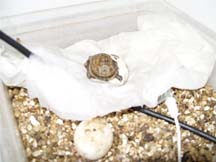
On taking the complete egg with hatchling enclosed out into the natural daylight, things started to take a downward spiral. The hatchling looked ash grey in colour, a colour that I would normally associate with someone being deprived of air. My hopes for this little hatchling were dropping by the minute. I angled the shell slightly and caught a glimpse of a large egg sack. Back into the incubator the complete egg went. At this point I felt completely deflated -- this was the first time my T.g.g. had laid eggs, and going from ecstatic bliss to the thought of losing this little one felt dreadful. Another mistake I made was naming it after my late mother (who could fail to resist this, pipping on what would have been her birthday?).
That afternoon there was no holding this little one back. Bessie had smelled fresh air and was determined to do it again soon! As I filled the newborn's bath with lukewarm water, I was not prepared for what I was about to see. A HUGE egg sack was dangling down from this poor little tortoise. It must have been longer than the length of its plastron.
With great urgency hubby was summoned to assist with this little one. Whilst he held the hatchling (with very clean hands), supporting its weight so as not to tear the egg sack, I made a circle out of kitchen roll, placed it in the water and then the tiny hatchling on top of this, to enable it to drink and to give me time to think what I should do. All I could think of was that it must stay moist and clean. Quickly I sterilised an egg cup, placed a small amount of damp kitchen paper on the bottom, and made another damp circle to place the tortoise on and dangle the cord and egg sack in the centre, thus having no weight on it at all. Back into the incubator again. Hourly checks were made to ensure that the paper remained damp and clean and that the little hatchling remained weight free and unable to scratch this egg sack.
Day 2 after Hatching
Still alive, with at least a third of the egg sack having been absorbed. Bessie weighed 6g and was becoming quite agitated being kept in the incubator. Due to the warm weather I decided to let her absorb some natural UVB from the sun whilst the egg sack remained moist in the bathing water.
Over the following Week
This method worked extremely well. 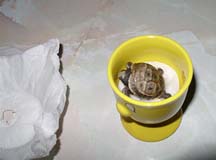 I would sit with Bessie on my lap, initially for about 15 minutes, and then she would sleep quite soundly in the incubator in her damp egg cup for about an hour. The wake time increased as the day(s) went on.
I would sit with Bessie on my lap, initially for about 15 minutes, and then she would sleep quite soundly in the incubator in her damp egg cup for about an hour. The wake time increased as the day(s) went on.
And I am very pleased to say that the abnormal egg sack decreased.
Day 11
Bessie has absorbed the complete egg sack, gained 1g in weight, has eaten, passed urine and had the tiniest poo. So for now all is well. What remains to be seen is whether Bessie thrives after such a dramatic start to life!
One Year On
Against the odds Bessie has in fact made it past her first birthday.
The past year was not without worry and indeed at one point I had thought that Mother nature had won her battle. During May, Bessie was not thriving and appeared lethargic. She was isolated, bathed with Reptoboost and I stopped the outdoor excursions to her enclosure as she was not moving around whilst out there.
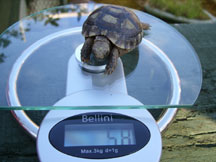
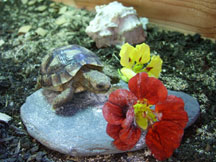
The combination of the above worked and Bessie turned the corner! She is the first one up in the morning and last one to bed. Weighing in at a healthy 58g with a SCL of 53mm Bessie has a zest for life.
Elaine Pearman





